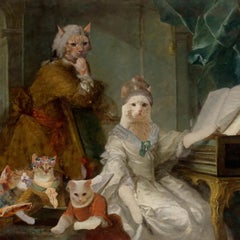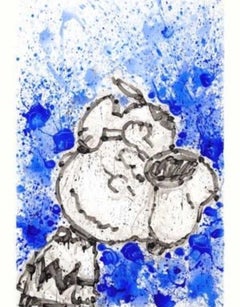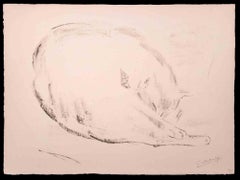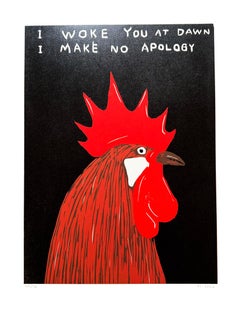Women Animal Prints
to
111
460
129
160
73
39
Overall Width
to
Overall Height
to
291
161
93
34
28
17
14
12
9
8
1
1
47
33
17
15
14
110
95
515
145
6
3
15
19
25
39
52
142
60
37
106
532
316
12
2,724
1,770
1,466
1,072
865
544
498
448
448
402
356
355
334
247
236
189
173
150
142
140
334
308
144
66
48
84
325
403
335
Art Subject: Women
Cat Family
Located in Jersey City, NJ
"Cat Family", 2021, digital collage, print, cats, victorian, figurative, Digital Painting and Drawing / Animals / Surrealistic / Dark Colors / Portrait
Category
2010s Contemporary Figurative Prints
Materials
Digital
Bird and Spirit Figure - Original Lithograph, Hand Signed (Ryckelynck #6641)
By Wifredo Lam
Located in Paris, IDF
Wifredo Lam
Bird and Spirit Figure, 1967
Original lithograph
Hand signed in pencil
Numbered / 300
On Arches vellum 50 x 65 cm (c. 20 x 26 in)
REFERENCE : Catalog raisonne Tonneau...
Category
1960s Modern Animal Prints
Materials
Lithograph
Hipster Dog Dreams
By Tom Everhart
Located in Toronto, ON
42" x 28.5" Unframed
Limited Edition Giclée & Silkscreen on Paper
Hand Signed by Tom Everhart
Category
2010s Animal Prints
Materials
Giclée, Screen
Cat - Original Lithograph by Giselle Halff - Mid 20th Century
Located in Roma, IT
Cat is an Original Lithograph realized by Giselle Halff (1899-1971).
Good conditions.
Hand-Signed.
Numbered. Edition, 2/15.
Giselle Halff (1899-1971) born in Hanoi, student of R....
Category
Mid-20th Century Modern Animal Prints
Materials
Lithograph
PIGEONS
Located in Aventura, FL
Selected from the personal collection inherited by Marina Picasso, Pablo Picasso's granddaughter. After Pablo Picasso's death, his granddaughter Marina authorized the printing of t...
Category
1980s Cubist Animal Prints
Materials
Paper, Lithograph
$1,025 Sale Price
50% Off
David Shrigley - I Woke You At Dawn, I Make No Apology - Edition of 30
Located in London, GB
David Shrigley
I Woke You At Dawn, 2024
Woodcut
53 x 40 cm
Edition of 30
hand-signed and numbered by the artist
published by Shäfer Editions and comes with COA from the publishers
D...
Category
2010s Contemporary Animal Prints
Materials
Woodcut
GREEN HORSE, TWO GEISHAS Signed Lithograph, Asian Women, Fan, Parrots, Flowers
By Walasse Ting
Located in Union City, NJ
GREEN HORSE, TWO GEISHAS is an original lithograph printed using hand drawn lithography techniques on archival Somerset printmaking paper, 100% acid free, by the renowned Chinese born artist Walasse Ting (DING XIONGQUAN, Chinese, 1929-2010). Ting's use of bold colors and expressive calligraphic brush drawn forms convey vivid life energy. He is well known for his colorful images of women, flowers, fish, parrots and horses and was associated with artists Karel Appel, Asger Jorn, and Pierre Alechinsky, members of the avant-garde group called COBRA. Throughout his artistic life, Ting imbued his passion and spirit into his paintings, poetry and sculpture. GREEN HORSE, TWO GEISHAS is a freely expressed Chinese Ink Brush drawing depicting a colorful bright green horse with dark blue mane and tail standing with two lovely dark green haired Asian women...
Category
1980s Contemporary Figurative Prints
Materials
Lithograph
$1,100 Sale Price
32% Off
LE PEINTRE A LA PALETTE (BLOCH 1153)
Located in Aventura, FL
Linocut on Arches wove paper. Hand signed and numbered by the artist in pencil. Image size 25 x 20.75 inches. Sheet size 29.6 x 24.5 inches. Frame size approx 34.5 x 29.5 inches. Pri...
Category
1960s Cubist Animal Prints
Materials
Paper, Linocut
$31,600 Sale Price
46% Off
Original Visitez Les Aquariums Mosans vintage poster
Located in Spokane, WA
"Original Vintage Aquariums Mosans Poster – Art Deco Design by A. de Loof, 1930s European Travel Advertising"
Discover the Captivating "Moselle Aquariums" - A Vintage Poster by A. d...
Category
1930s Art Deco Landscape Prints
Materials
Lithograph
Fight the Fucking Asshole Fuckwit Bastards
Located in Manchester, GB
David Shrigley, Fight the Fucking Asshole Fuckwit Bastards, 2020
80 x 60 cm
Off-set lithography
Printed on 200g Munken Lynx paper Narayana Press in Denmark
David Shrigley is a B...
Category
2010s Contemporary Prints and Multiples
Materials
Lithograph
Roll your own, American Western Art Lithograph by Noel Daggett
By Noel Daggett
Located in Long Island City, NY
Noel Daggett, American (1925 - 2005) - Roll your own, Year: circa 1979, Medium: Lithograph, signed and numbered in pencil, Edition: 300, AP 40, Image Size: 20 x 22 inches, Size: ...
Category
1970s American Realist Animal Prints
Materials
Lithograph
German Manner of Netting Partridges, aquatint engraving hunting print, 1813
Located in Melbourne, Victoria
'German Manner of Netting Partridges'
Colour aquatint by Merke after Franz Joseph Manskirch (1768-1830).
From Samuel Howitt's 'Foreign Field Sports'. Samuel Howitt was an English p...
Category
Early 19th Century Naturalistic Animal Prints
Materials
Aquatint
PERCY AT THE FRIDGE Signed Lithograph, Black Cat, Champagne, British Humor
By Beryl Cook
Located in Union City, NJ
PERCY AT THE FRIDGE is a hand drawn, pencil signed limited edition lithograph by the well known and loved British artist and humorist, Beryl Cook. Printed on archival Arches paper, 100% acid free, print size 28" x 21", image size 21 3/8" x 17". In this amusing depiction, "Percy" refers to the aristocratic black cat who sits patiently waiting in front of the open refrigerator stocked with fine champagne, canned salmon, milk, cream, roast turkey, and other gourmet delicacies all tempting items from his genteel mistress's offerings. She stands holding her spectacles, dressed in a jeweled tiara, long white evening gloves and light blue evening gown...
Category
1990s Contemporary Portrait Prints
Materials
Lithograph
$1,600 Sale Price
31% Off
Rhinoceros
Located in Hollywood, FL
ARTIST: Salvador Dali
TITLE: Rhinoceros
MEDIUM: Etching
SIGNED: Hand Signed
PUBLISHER: Michelle Broutta, Paris
EDITION NUMBER: 97/150
MEASUREMENTS: 35.4" x 25"
YEAR: 1971
F...
Category
1970s Surrealist Animal Prints
Materials
Etching
Les Printemps D'Uranus Cheval (75% OFF LIST PRICE LIMITED TIME ONLY)
Located in Kansas City, MO
Jean-Marie Guiny
"Les Printemps D'Uranus Cheval"
Lithograph
Signed and numbered by the artist
Edition: H.C.
Size: 19.5 x 25.75 inches
COA provided
*Condition: Good; no foxing, stain...
Category
Late 20th Century Contemporary Animal Prints
Materials
Lithograph
$198 Sale Price
75% Off
Original Hawaii, United Air Lines vintage travel poster Hawaiiana
Located in Spokane, WA
Original United Air Lines Hawaii vintage travel poster. Archival linen backed in excellent condition, ready to frame. The images shown are of the ...
Category
1960s American Modern Figurative Prints
Materials
Offset
Monkey Isn't Thinking About You
Located in London, GB
David Shrigley
Monkey Isn't Thinking About You, 2021
Digital print
70 x 50 cm
Framed 90 x 70 cm
unsigned Edition of 250
Published by Shrig Shop.
...
Category
2010s Contemporary Animal Prints
Materials
Digital
Horses 2, Israel (1966) by Hans Erni - Lithograph 50x70 cm
By Hans Erni
Located in Geneva, CH
Lithograph numbered and signed by hand
19/60 edition
From Israel collection
Category
1960s Surrealist Animal Prints
Materials
Lithograph
$560 Sale Price
20% Off
Raoul Dufy (after) - Autoportrait - Lithograph
By Raoul Dufy
Located in Collonge Bellerive, Geneve, CH
(after) Raoul Dufy
Lithograph after a watercolor, published in the book "Lettre à mon peintre Raoul Dufy." Paris, Librairie Académique Perrin, 1965.
Printed signature
Dimensions: ...
Category
1940s Fauvist Animal Prints
Materials
Lithograph
Five images from the popular 1886 Spanish Bullfighting Journal La Lidia
Located in Paonia, CO
La Lidia, the oldest and most popular bullfighting magazine was founded by Julian Palacios the owner of a prestigious lithograph and engraving workshop in Madrid. These colorful...
Category
1880s Realist Figurative Prints
Materials
Lithograph
Three Birds Flying - Original Lithograph (Mourlot #82)
Located in Paris, IDF
Georges BRAQUE (1882-1963)
Composition with Birds, 1965
Original lithograph (Mourlot workshop)
Signed in the plate
On vellum 30 x 24 cm (c. 11.8 x 9.4 in)
REFERENCES :
- Catalog r...
Category
1960s Abstract Geometric Animal Prints
Materials
Lithograph
Picasso, Le Papillon, Histoire naturelle (after)
Located in Southampton, NY
Lithograph on papier bouffant des Papeteries de Casteljoux paper. Unsigned and unnumbered, as issued. Good condition. Notes: From the folio, Eaux-fortes originale pour des textes de ...
Category
1970s Modern Landscape Prints
Materials
Lithograph
$716 Sale Price
40% Off
Picasso "Toros & Toreros" Photolithography
Located in Cuauhtemoc, Ciudad de México
This framed Picasso print, is an offset lithographic book plate from a captivating book, entitled Toros y Toreros (Bulls and Bullfighters), which ...
Category
Mid-20th Century Cubist Animal Prints
Materials
Lithograph
Erté, Ebony in White, 1982
By Erté
Located in Fairfield, CT
Artist: Erte, Romain de Tirtoff (1892-1990)
Title: Ebony in White
Year: 1982
Medium: Lithograph on wove paper
Size: 33 x 24 inches
Condition: Good
Inscription: Signed by the artist
N...
Category
1980s Art Deco Figurative Prints
Materials
Lithograph
$876 Sale Price
20% Off
Ducks at Play, Signed Modern Etching Mounted to Board by Frank Weston Benson
Located in Long Island City, NY
Ducks at Play
Frank Weston Benson, American (1862–1951)
Date: 1940
Etching mounted to board, signed and dated in pencil
Image Size: 10 x 8 inches
Size: 12 x 10 in. (30.48 x 25.4 cm)
Category
1940s Modern Animal Prints
Materials
Etching
Red Horse 1981 Signed Limited Edition Lithograph
By Walasse Ting
Located in Rochester Hills, MI
Walasse Ting
Red Horse – 1981
Print – Lithograph on Arches Paper 17.5” x 23.5”
Edition: H.C. signed Hors d'Commerce
Walasse Ting was a Chinese-American vi...
Category
1980s Pop Art Animal Prints
Materials
Lithograph
'Mazeppa' — 19th-Century French Romanticism
Located in Myrtle Beach, SC
Théodore Géricault and Eugène Lami, 'Mazeppa' from the series 'Oeuvres de Lord Byron', lithograph, 1823, 2nd state of 3, Delteil 94. Rendered by Thé...
Category
1820s Romantic Animal Prints
Materials
Lithograph
The Large Horse by Albrecht Dürer
Located in New Orleans, LA
Albrecht Dürer
1471-1528 German
The Large Horse
Dated in the plate on upper margin at center; monogrammed in the plate lower right: AD
Meder state e (of...
Category
16th Century Northern Renaissance Animal Prints
Materials
Laid Paper, Engraving
Emilio Vedova - Original Lithograph
Located in Collonge Bellerive, Geneve, CH
Emilio Vedova - Original Lithograph
Abstraction
1961
From the art revue XXe Siecle
Dimensions: 32 x 24
Edition: G. di San Lazzaro.
Unsigned and unumbered as issued
Category
1960s Modern Figurative Prints
Materials
Lithograph
Marc Chagall - The Green Horse - Original Lithograph
By Marc Chagall
Located in Collonge Bellerive, Geneve, CH
Marc Chagall
Original Lithograph
Title: The Green Horse
1973
Dimensions: 33 x 50 cm
Reference: This lithograph was created for the portfolio "Chagall Monu...
Category
1970s Surrealist Figurative Prints
Materials
Lithograph
The Flight into Egypt 17th century engraving after Rubens by Lucas Vorsterman
By Peter Paul Rubens
Located in London, GB
To see more, scroll down to "More from this Seller" and below it click on "See all from this Seller."
Lucas Vorsterman (1595 - 1675) after Peter Paul Rubens (1577 - 1640)
The Fligh...
Category
1620s Realist Landscape Prints
Materials
Engraving
Salvador Dali "Untitled III (Le Tricorne)"
Located in Boston, MA
Artist: Dali, Salvador
Title: Untitled III (Le Tricorne)
Series: Le Tricorne (The Three-Pointed Hat)
Date: 1959
Medium: Wood engraving
Unframed Dimensions: 12.6" x 8.8"
Framed...
Category
1950s Surrealist Prints and Multiples
Materials
Engraving
'Happy Tidings', Geisha, Holding a Fan, Receives a White Crane, Silk Kimono
By Miharu Lane
Located in Santa Cruz, CA
Signed lower center, 'Miharu Lane' (Japanese-American, born 1948), titled, 'Happy Tidings' and with number and limitation, '193/350'. Paper dimensions: 19 x 24 inches.
Miharu Lane ...
Category
1990s Contemporary Animal Prints
Materials
Paper, Lithograph
Surreal Floral Portrait Print with Camellia on Green – Limited Edition
Located in FISTERRA, ES
This surreal floral portrait print by Natasha Lelenco is part of her Fetiches series and explores the fusion of botanical elements with human portraiture through a surrealist lens. F...
Category
2010s Contemporary Portrait Prints
Materials
Metal
Picasso, Le Singe, Histoire naturelle (after)
Located in Southampton, NY
Lithograph on papier bouffant des Papeteries de Casteljoux paper. Unsigned and unnumbered, as issued. Good condition. Notes: From the folio, Eaux-fortes originale pour des textes de ...
Category
1970s Modern Landscape Prints
Materials
Lithograph
$716 Sale Price
34% Off
Brunelleschi, Composition, La Leçon d'amour dans un parc (after)
Located in Southampton, NY
Lithograph and stencil on vélin d’Arches paper. Unsigned and unnumbered, as issued. Good condition. Notes: From the volume, La Leçon d'amour dans un parc, 1933. Published by Éditions...
Category
1930s Modern Landscape Prints
Materials
Lithograph, Stencil
$1,436 Sale Price
20% Off
Luna llena (Full Moon) (1/30)
Located in San Francisco, CA
Rocca Luis César
Luna llena (Full Moon), 2023
Serigraph in five colors
21.70 x 21.70 in
Edition of 30
This serigraph (silkscreen or screen print) is ...
Category
21st Century and Contemporary Modern Animal Prints
Materials
Screen
Before You can Entertain Others ... Limited Edition Print
Located in Hong Kong, HK
Before You can Entertain Others... You Must First Learn to Entertain Yourself by David Shrigley
14 colour screenprint with a varnish overlay
75 x 56 cm
Edition 40 of 125
Signed, date...
Category
2010s Animal Prints
Materials
Screen
Original "Queen of the Jungle" US 1-sheet vintage (1935) movie poster
Located in Spokane, WA
Original Queen of the Jungle vintage lithograph movie poster, archival linen backed. US 1-sheet.
"The Temple of Mu." Serial. Episode No 10. St...
Category
1930s American Modern Animal Prints
Materials
Lithograph
$760 Sale Price
20% Off
Cat - Original Lithograph by Giselle Halff - Mid 20th Century
Located in Roma, IT
Cat is an Original Lithograph realized by Giselle Halff (1899-1971).
Edition of 4/13.
Good conditions.
Hand-Signed.
Giselle Halff (1899-1971) born in Hanoi, student of R.X. Prine...
Category
Mid-20th Century Modern Animal Prints
Materials
Lithograph
Returning to the Stable.
Located in Storrs, CT
Returning to the Stable. 1920. Drypoint. Appleby 64. 8 3/4 x 12 1/4 (sheet 11 7/16 x 16 1/8). Edition 100. A rich impression printed on cream laid paper wi...
Category
1920s Modern Interior Prints
Materials
Drypoint, Etching
$800 Sale Price
36% Off
RED HORSE ON ORANGE, THREE GEISHAS Signed Lithograph, Asian Women, Parrots, Fan
By Walasse Ting
Located in Union City, NJ
Red Horse on Orange, Three Geishas is an original hand drawn lithograph on archival Somerset printmaking paper, 100% acid free, by the renowned Chinese born artist Walasse Ting (DING...
Category
1980s Contemporary Animal Prints
Materials
Lithograph
Hunt Slonem "White Bunnies VI" Lithograph
By Hunt Slonem
Located in Boston, MA
Artist: Slonem, Hunt
Title: White Bunnies VI
Series: Bunnies
Date: 2017
Medium: Lithograph on Paper
Unframed Dimensions: 24" x 16"
Framed Dimensions: 29" x 22"
Signature: Sig...
Category
2010s Contemporary Animal Prints
Materials
Lithograph
$2,320 Sale Price
20% Off
Surreal Botanical Portrait Print on Purple – Limited Edition Dibond
Located in FISTERRA, ES
This surreal botanical portrait print by Natasha Lelenco belongs to her acclaimed Fetiches series. The limited edition print features a vibrant purple background and a surrealist figure with a cabbage for a head, adorned with a yellow beanie and insect companions. This whimsical character merges elements of nature, human anatomy, and humor, creating a surreal portrait that evokes both biophilia and dreamlike absurdity.
Inspired by the tradition of surrealism and the legacy of Arcimboldo, Lelenco's work pushes the boundaries of contemporary portraiture. The anthropomorphic form in this piece explores identity and our symbolic relationship with the natural world, making it an ideal fit for collectors of surrealist-inspired art.
Each Dibond direct UV print in the edition is individually hand-varnished, signed, and numbered on the reverse by the artist. Subtle hand-finished details and intense color saturation give this print a luminous, high-end presence. It is ready to hang with an integrated floating system, or can be framed to your preference.
About the Series
Fetiches is a series of surreal portraits that blend botanical elements with anthropomorphic forms. Lelenco’s works explore themes of memory, absurdity, and the kitsch imaginary of childhood, all filtered through a queer and eco-poetic lens. The figures, built from fruits, vegetables and organic matter, challenge traditional notions of beauty, identity, and belonging.
Technical Details
Technique: UV direct print on Dibond, hand-varnished
Edition: Limited to 25 copies, signed and numbered on the back
Dimensions: 30 x 40 cm
Finish: Floating mount, ready to hang
Keywords
Surreal Botanical Portrait, Cabbage Head, Limited Edition Dibond, Anthropomorphic Art...
Category
2010s Contemporary Portrait Prints
Materials
Metal
$170 Sale Price
20% Off
Barnacle Geese Affrighted
Located in Middletown, NY
Etching and drypoint on cream wove paper, full margins. Signed and numbered 59/75 in pencil, lower margin. Notations in pencil along the lower sheet edge, recto, well outside of ima...
Category
Mid-20th Century Modern Animal Prints
Materials
Handmade Paper, Drypoint, Etching
The Cat - Original Etching by Giselle Halff - 1950s
Located in Roma, IT
The Cat is an Original etching print on paper realized by Giselle Halff in 1950 ca.
Good conditions with some foxing.
.
Category
1950s Modern Animal Prints
Materials
Etching
The Coach and the Flies - Etching - 1974
Located in Roma, IT
The Coach and the Flies is an artwork realized in 1974.
Etching and drypoint with stencil.
59 x 79 cm.
Printed by Atelier Rigal. Edition XIV/CXX on Auvergne paper.
It belongs to...
Category
1970s Surrealist Figurative Prints
Materials
Etching
Ass and the Lion Hunting, antique animal fable etching by Samuel Howitt
Located in Melbourne, Victoria
Original antique etching by Samuel Howitt (1756-1822) . C1810. Published by Edward Orme.
An early 19th century etching by Howitt from a series depicting ...
Category
Early 19th Century Naturalistic Animal Prints
Materials
Engraving, Etching
Sea Dragon - Etching by M. Chirnoaga - Late 20th Century
Located in Roma, IT
Sea Dragon is an original etching artwork by Marcel Chirnoaga (Romanian, 1930–2008) one of the most important artists of fantasy painting and mythology subj...
Category
Late 20th Century Contemporary Animal Prints
Materials
Etching
Picasso "Toros & Toreros" Photolithography
Located in Cuauhtemoc, Ciudad de México
This framed Picasso print, is an offset lithographic book plate from a captivating book, entitled Toros y Toreros (Bulls and Bullfighters), which ...
Category
Mid-20th Century Cubist Animal Prints
Materials
Lithograph
Chauvesouris - Etching by Louis Legrand - 1771
Located in Roma, IT
Chauve- souris is an etching realized in 1771 by Louis Legrand (1723-1807).
Titled and Signed on the plate.
The artwork Belongs to the suite "Histoire naturelle, générale et partic...
Category
1770s Modern Figurative Prints
Materials
Etching
Horse Laugh
Located in New York, NY
Alfred Bendiner (1899-1964) was trained as an architect but worked as an artist throughout his career. He was a noted lithographer, as well an author, muralist, and caricaturist. The...
Category
Mid-20th Century American Modern Animal Prints
Materials
Crayon
Robert Marx, Blind Hunter
Located in New York, NY
German-born Robert Ernst Marx was a painter, printmaker, and teacher. His main subject was the human condition. This intaglio is somewhat unusual in ...
Category
1960s American Modern Figurative Prints
Materials
Intaglio
Condor, Folk Art Screenprint by Victor Delfin
Located in Long Island City, NY
This print was created by Peruvian artist Victor Delfin. Delfin found the source of his inspiration in the ancient Paracan culture of Peru, part of the broader Incan civilization. De...
Category
1980s Folk Art Animal Prints
Materials
Screen
English Terriers, English Victorian dog chromolithograph, 1881
Located in Melbourne, Victoria
"Silvio," the Property of Mr. Alfred Benjamin. "Serpolette,"the Property of Mr. Tom. B. Swinburne. "Salford," the Property of Sir Wm. E. H. Verner, Bart.
English 19th century chrom...
Category
Late 19th Century Naturalistic Animal Prints
Materials
Lithograph
MAGENTA HORSE, THREE GEISHAS Signed Lithograph, Asian Women, Horse, Parrots
By Walasse Ting
Located in Union City, NJ
MAGENTA HORSE, THREE GEISHAS is an original lithograph printed using hand drawn lithography techniques on archival Somerset printmaking paper, 100% acid free, by the renowned Chinese born artist Walasse Ting (DING XIONGQUAN, Chinese, 1929-2010). Ting's use of bold colors and expressive calligraphic brush drawn forms convey vivid life energy. He is well known for his colorful images of women, flowers, fish, parrots and horses and was associated with artists Karel Appel, Asger Jorn, and Pierre Alechinsky, members of the avant-garde group called COBRA. Throughout his artistic life, Ting imbued his passion and spirit into his paintings, poetry and sculpture. MAGENTA HORSE, THREE GEISHAS is a freely expressed Chinese Ink Brush drawing depicting a colorful magenta horse with dark purple black mane and tail standing with three lovely Asian women...
Category
1980s Contemporary Figurative Prints
Materials
Lithograph
Last to Arrive, American Western Art Lithograph by Noel Daggett
By Noel Daggett
Located in Long Island City, NY
Noel Daggett, American (1925 - 2005) - Last to Arrive, Year: circa 1979, Medium: Lithograph, signed and numbered in pencil, Edition: 300, AP 40, Image Size: 19 x 23 inches, Size:...
Category
1970s American Realist Animal Prints
Materials
Lithograph
Dancers
Located in San Francisco, CA
This artwork titled "Dancers" c.1990is a color offset lithograph by noted equine American artist Fred Stone, 1930-2018. It is hand signed in pencil by the a...
Category
Late 20th Century American Realist Animal Prints
Materials
Lithograph
Knight fighting with Serpent - Original Etching by Giselle Halff - 1950s
Located in Roma, IT
Knight fighting with serpent is an original etching on ivory-colored paper realized by Giselle Halff in the mid-20th century.
Hand-signed at the bottom in pencil, and written "E.A" ...
Category
Mid-20th Century Modern Animal Prints
Materials
Etching
Horse Team - Original Etching by F. Jacque - Late 19th Century
By Frédéric Jacque
Located in Roma, IT
Horse Team is a black and white etching realized by Frederic Jacque in the late 19th Century.
The artwork represents a farmer and horses struggling with rural jobs
Good condition e...
Category
Late 19th Century Naturalistic Figurative Prints
Materials
Etching
Recently Viewed
View AllMore Ways To Browse
Mayuka Yamamoto
Milton Glaser Saratoga Festival
Oriental Field Sports
Peter Blake Eiffel Tower
Proboscis Monkey
Robert Ernst Marx Art
Robert Ernst Marx Prints
Robert Ernst Marx
Rodrigue City Slicker
Rodrigue Pueblo Puppies
Rodrigue The Rat Pack
Rolf Knie
Saw Whet Owl
Wilfred Fairclough
19th Century Goya Bullfighting Prints
Basil Ede Art
Basil Ede Print
Basil Ede




